AI in the classroom is rapidly changing the education landscape. It feels like new AI tools appear almost daily, and schools are shifting from trying to ban them to figuring out how to use them effectively with students.
For many educators, especially those in writing-heavy courses like English, this new frontier feels overwhelming. The primary concern often revolves around academic integrity, with teachers spending a TON of valuable time trying to detect AI-generated content in student work. This has led some teachers to revert to on-demand, in-class writing, but that approach may not be what’s best for student learning. In fact, we were just discussing this in my office yesterday.
Should we punish all for the crimes of a few? It’s getting harder and harder to tell (and there aren’t reliable AI detectors). One of my colleagues threw up his hands in frustration and declared that he was going to have his students hand write EVERY THING for the rest of the school year.
While I’m on board the frustration train, I think that the conversation about AI in the classroom needs to move beyond just “cheating.”
Instead, we can explore how to leverage AI as a powerful partner when appropriate. Set clear guidelines while designing authentic assessments that foster the critical thinking, creativity, and real-world skills students truly need. This post will explore the challenges and opportunities of AI in the classroom, offering strategies for creating engaging, AI-resistant assignments and integrating these tools responsibly.
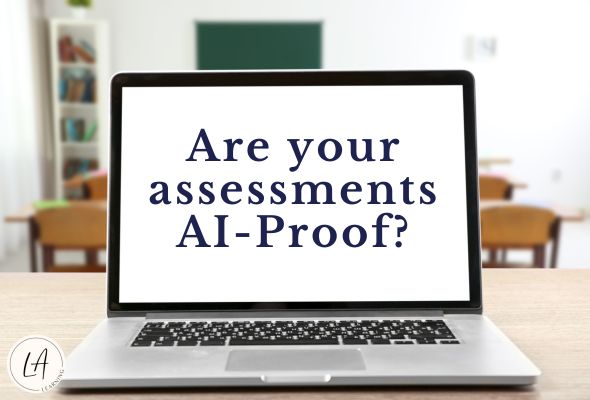
Rethinking Assessment in the Era of AI in the Classroom
The rise of sophisticated AI in the classroom (because whether we like it or not, it’s an uninvited guest) means we can no longer rely solely on traditional essays and worksheets to gauge student understanding.
If an assignment can be completed by a chatbot, it might be time to question the assignment itself, not just the student’s methods. Students often turn to AI because the task feels like busy work, or it’s so difficult that they feel desperate. Or…they lack executive functioning skills and managed their time poorly.
Our best defense is a great offense. The solution lies in creating assessments that are inherently human.
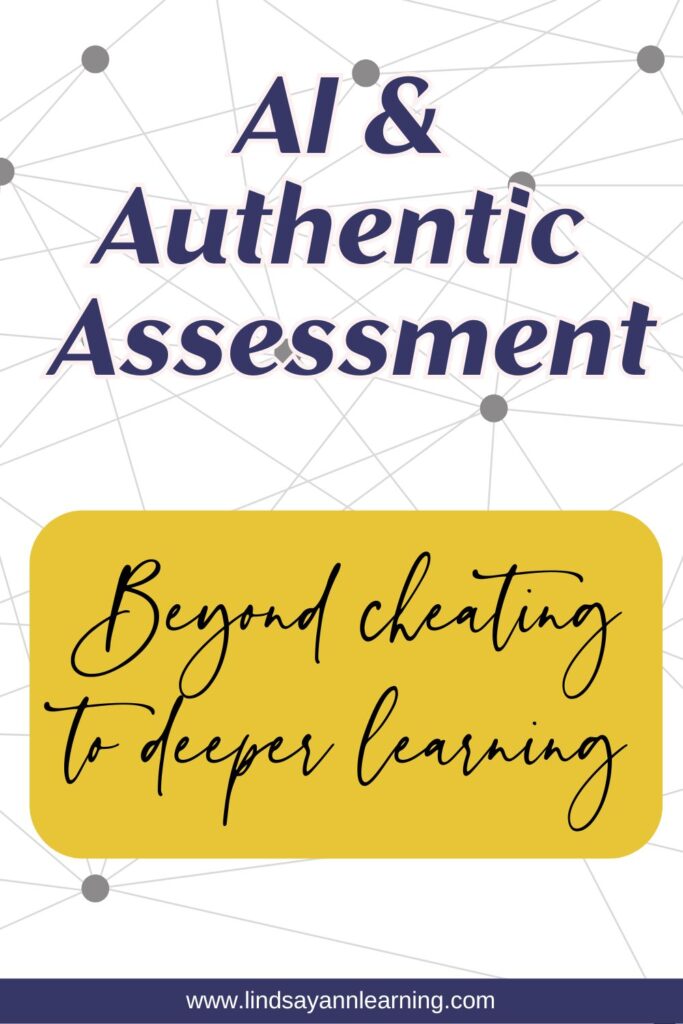
Authentic assessment focuses on tasks that require students to apply their knowledge and skills in meaningful, real-world contexts. These assignments are often multi-layered, process-oriented, and require personal insight, making them naturally resistant to shortcuts enabled by AI in the classroom.
What Makes an Assessment “AI-Resistant” in the Classroom?
AI-resistant, or AI-proof, assignments are designed to require thinking and skills that current AI models can’t easily replicate. They move beyond simple information recall and push students toward higher-order thinking, something no amount of AI in the classroom can replace.
Key elements of AI-resistant authentic assessment include:
- Personal Connection and Reflection: Ask students to connect course concepts to their own lives, experiences, and cultural contexts. AI in the classroom can’t fake a personal journal or genuine metacognition.
- Real-World Application: Require students to conduct their own research, perform interviews, or collect original data, all grounded in actual experience.
- Creativity and Multimedia: Incorporate creative components like podcasts, video explanations, visual art, or short stories. These formats demand an original, artistic voice that AI in the classroom struggles to produce authentically.
- Collaboration and Dialogue: Tasks such as panel discussions, debates, Socratic seminars, or partner interviews require real-time, in-the-moment interaction and synthesis that can’t be outsourced to a machine.
By focusing on these elements, we shift the goal from producing a perfect final product to engaging in a rich learning process, even as AI in the classroom becomes more prevalent.
Designing Authentic Assessments for the Modern Classroom
So, what does this look like with AI in the classroom? Let’s consider a traditional literary analysis essay. An AI tool might be able to generate a passable analysis of a common text. But what if we redesigned it to highlight human learning?
Here are some ideas of the literary analysis essay re-imagined. For the sake of example, I’ll pretend that the unit is on “coming of age.”
- “Portraits of Growing Up” Multimedia Exhibit: Instead of a standard essay, students could create a multimedia “exhibit” exploring a thematic idea. This is a project worth embracing in a modern classroom where AI is common.
- Literary Lens Analysis (Audio/Video): Students record a 3–5 minute analysis explaining how a protagonist grows and changes, connecting the text’s themes to modern adolescence. The use of voice adds a human perspective that AI in the classroom can’t manufacture.
- Creative Component (Student Choice): Students create an original piece (like a digital collage, a fictional character’s journal, or a podcast interview) that represents the theme, accompanied by an artist’s statement explaining their creative choices.
- “Then and Now” Interactive Interview (Partners): In pairs, students role-play a character from the text, with one portraying the character at the beginning of their journey and the other as the same character in adulthood. This live performance emphasizes empathy, synthesis, and collaboration, skills that remain human even with AI in the classroom.
- “How to” Guide: Students + authors of texts they’re analyzing are co-authors of a guide or manual on a thematic topic. This allows for more student choice and voice alongside natural literary analysis of authors’ ideas.
- Peer Gallery Walk and Reflection: Students engage with classmates’ exhibits and submit a reflection on the universal insights they discovered. This builds community and reinforces pattern recognition, bringing together real voices in the age of AI.
This kind of multi-layered, authentic assessment is not only engaging but also nearly impossible for AI in the classroom to complete on behalf of a student. It evaluates a wide range of skills, from analytical writing and creativity to collaboration and oral communication.
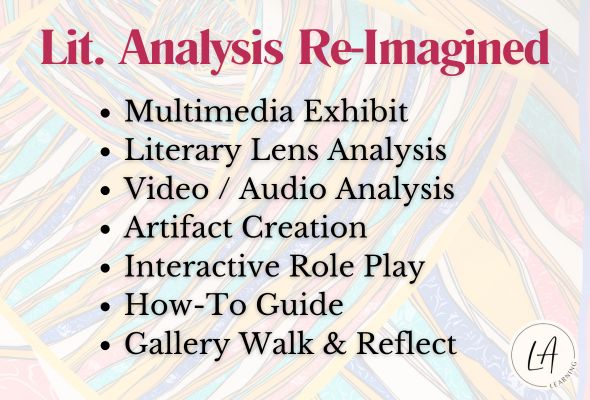
Additional AI-Resistant Assignment Ideas for Your Classroom
To expand your toolbox in a world full of AI in the classroom, try more approaches for authentic assessment. Each of these suggestions taps into skills, creativity, or personal connection that AI cannot replicate:
- Short Presentations: Students present their thinking about character development or theme in a novel chapter, responding to real-time questions from classmates.
- Collaborative Discussions: Involve students in whole-class or small group dialogues on key topics, followed by reflective summaries referencing specific peer contributions.
- Research Videos with Reflection: Students record themselves explaining their research on an inquiry question and reflect on their learning.
- Live Annotation and Analysis: Students annotate a text and then discuss it live, either one-on-one or with a group, showing their understanding and reasoning on the spot.
- “They Say, I Say” Posts: Assignments where students reflect on current issues and add their own voice and viewpoint to the conversation.
- Creative Self-Analysis: After composing an essay or poem, students add comments analyzing their own writing choices, exploring technique and rubric alignment.
- Personal Experience Vignettes: Students craft a brief narrative around a personal event and reflect on the theme it reveals.
- Visual and Written Synthesis: Assignments that combine artwork or visuals with written interpretation, requiring synthesis and creative expression.
- Connection and Synthesis Activities: Tasks that ask students to link learning to their own experiences or synthesize it with another text.
- Micro Lab Protocols: Rapid discussion formats that prioritize active listening and critical thinking in the moment.
All of these encourage skills and habits that are invaluable, even as AI in the classroom becomes more prevalent.
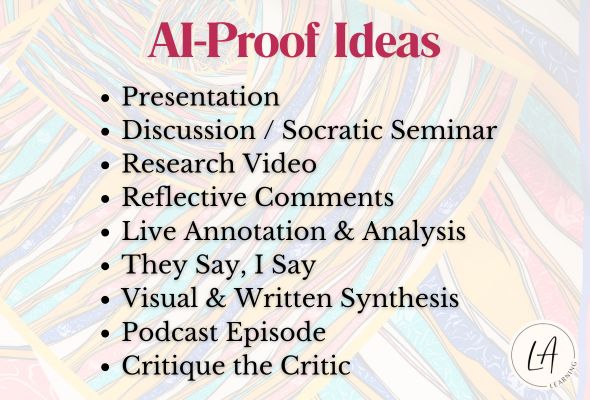
Transforming AI-Vulnerable Assignments into Authentic, AI-Resistant Assessments
- Former Assignment: Write an essay about theme development in Born a Crime.
AI-Resistant Alternative: Participate in a Socratic Seminar to explore theme development and make personal and inter-textual connections, followed by reflection on new insights.
Why This Works: It foregrounds collaborative discourse, deeper thinking, and authentic self-reflection. - Former Assignment: Research a topic and create an annotated bibliography.
AI-Resistant Alternative: Create a podcast that weaves research and storytelling to answer an original inquiry question.
Why This Works: Students synthesize research with personal perspectives, producing an original, creative product. - Former Assignment: Answer questions about a short story.
AI-Resistant Alternative: Role play as characters from the story and reflect on character motivations using evidence from the text.
Why This Works: This task demands live, composed analysis and abstract thinking, which AI in the classroom cannot provide for students. - Former Assignment: Write a critique of the novel Their Eyes Were Watching God.
AI-Resistant Alternative: Read and respond to a piece of literary criticism, arguing both for and against a point made by the critic using textual evidence and analysis.
Why This Works: Encourages rigorous argumentation and personal response through dialogue with both a critic and the text. - Former Assignment: Write and perform a slam poem.
AI-Resistant Alternative: Write a slam poem and add commentary analyzing craft and performance choices in relation to the poem’s central message.
Why This Works: This assignment centers critical thinking and metacognition as students interpret and explain their creative decisions, something AI in the classroom can’t fully emulate.
Finding a Responsible Role for AI in the Classroom
Designing AI-resistant assignments does not mean we should ban AI in the classroom completely.
Students will use these tools in their future careers, so it’s our responsibility to teach them how to use AI in the classroom ethically and effectively. The key is to establish clear expectations and move from a mindset of policing to one of partnership.
Setting Clear Guidelines for AI in the Classroom
We cannot assume students know what is and isn’t appropriate when it comes to AI in the classroom. Co-creating guidelines with students for different types of assignments can be a powerful exercise. Use a continuum to discuss various uses, from using AI to brainstorm or check grammar (often acceptable) to asking it to generate entire paragraphs or ideas (often unacceptable). Clear expectations empower students to make responsible decisions and ensure fairness with AI in the classroom.
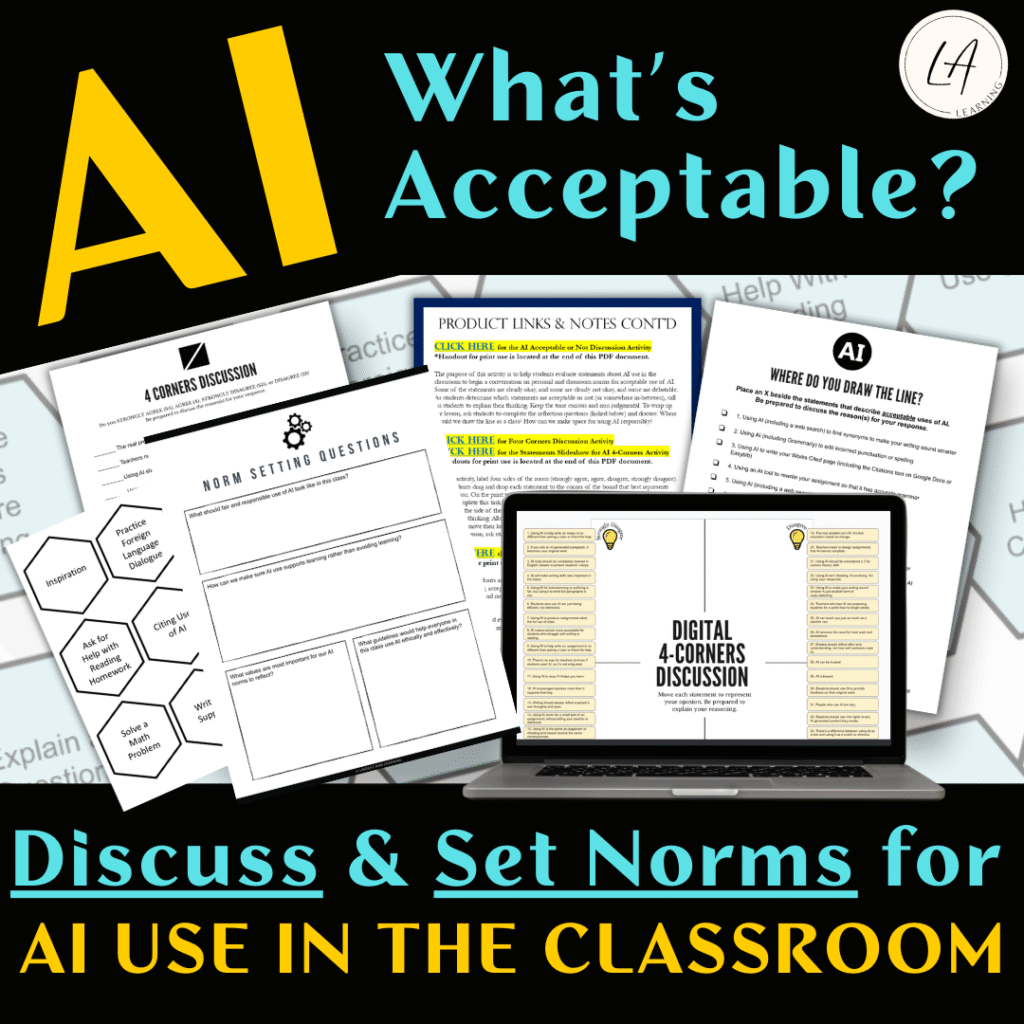
AI as a Tutor, Not a Cheater
AI in the classroom can be an incredible support for the learning process. With proper guidance, students can use AI as a:
- Brainstorming Partner: To generate initial ideas when they feel stuck.
- Revision Coach: To get immediate, formative feedback on a draft, helping them identify weaknesses in structure or clarity before submitting it for a grade.
- Study Buddy: To create practice questions, summarize complex concepts, or build study guides.
For example, a teacher can set up a controlled environment using a platform like SchoolAI, where students submit a draft and interact with a chatbot programmed to act as a writing mentor. (Fair warning…this requires quite a bit of teacher “training” of the AI tool on the back-end so that this the chatbot doesn’t just fix students’ writing for them and actually gives them helpful advice.)
The AI tool can ask probing questions about their analysis or evidence, guiding students to a deeper understanding of their own work without giving them the answers. This allows for personalized, immediate feedback, making AI in the classroom a true partner in the writing process.
The Challenge of Grading Authentic Assessments in a Classroom with AI
One of the biggest hurdles for teachers is the time commitment required to grade complex, multi-layered authentic assessments, especially when AI in the classroom means student output can come in many new formats. Listening to podcasts, watching videos, and evaluating creative projects for dozens of students can be daunting. How can we manage this workload without burning out?
While there’s no single easy answer, a combination of strategies can help:
- Use Clear Rubrics: A well-designed rubric, especially a single-point rubric, can streamline grading by focusing on specific learning targets.
- Leverage Student Self-Reflection: Require students to submit a reflection checklist with their work, explaining how they met the requirements. This shifts some of the cognitive load and encourages metacognition.
- Embrace AI for Formative Feedback: Use AI in the classroom, like Brisk or programmed chatbots, to provide initial feedback on low-stakes, objective elements. This “flywheel” model frees up teacher time to focus on what humans do best: evaluating creativity, style, and depth of thought.
- Focus on Process over Product: Not every component of a project needs a detailed grade. Emphasize feedback on the process and use the final product primarily as a summative measure.
Moving Forward with Confidence. Embracing AI in the Classroom
The integration of AI in the classroom is not a passing trend. It requires a fundamental shift in how we think about teaching, learning, and assessment. By embracing authentic assessment, we can create engaging educational experiences that foster durable skills like critical thinking, creativity, and collaboration.
Instead of fearing AI in the classroom, let’s learn to partner with it. Let’s design assignments that celebrate human insight and empower students to use technology as a tool for growth, not a shortcut to avoid real learning. The future of education lies in the thoughtful balance of human connection and technological innovation with AI in the classroom as a catalyst, not a replacement.
Related Resources:
- Student Blog Writing Unit BUNDLE: Persuasive Writing, Argumentation, Summary
- Slam Poetry Unit Activities MEGA BUNDLE for Middle School & High School English
- Artificial Intelligence Activities: ChatGPT, AI Use, Academic Integrity


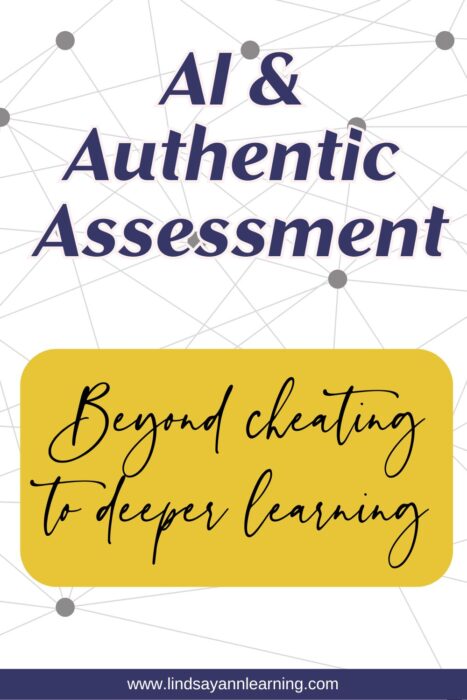
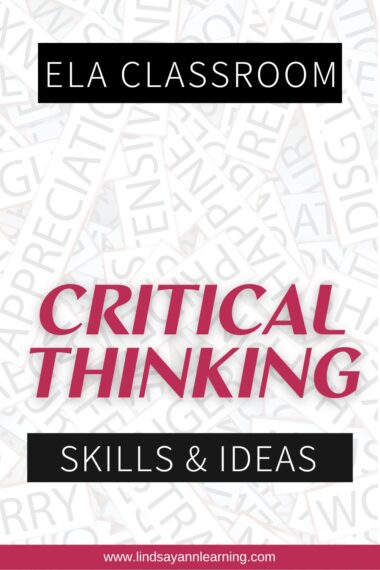











 Encouraging Growth Mindset in Students: Strategies and Examples for Teachers
Encouraging Growth Mindset in Students: Strategies and Examples for Teachers